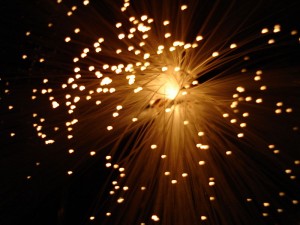'Optical fiber 2.0' based on a crystalline core

Optical fibers are three times as thick as a human hair and can transmit over a terabyte - the equivalent of 250 DVDs - of information per second. But there is still room for improvement.

The new class of optical fiber has a wider wavelength range and superior optical and electronic qualities to the amorphous core fibers in use today.
It allows for more effective manipulation of light and potentially more versatile laser-radar technology.
"The key advantage is that these fibers operate over a wide wavelength range, specifically into the long IR and, just as importantly, that one can exploit the materials properties of crystalline compound semiconductors," said John Badding, a professor of chemistry at Penn State University who is leading the research.
The new technology can lead to improved surgical and medical lasers, better countermeasure lasers used by the military, and superior environment-sensing lasers such as those used to measure pollutants and to detect the dissemination of bioterrorist chemical agents.
Badding explained in a release that optical-fiber technology always has been limited by the use of a glass core. "Glass has a haphazard arrangement of atoms. In contrast, a crystalline substance like zinc selenide is highly ordered. That order allows light to be transported over longer wavelengths, specifically those in the mid-infrared," Badding said.
But to get the crystalline compound inside optical fibers took some finesse since it had never been done before.
Using an innovative high-pressure chemical-deposition technique developed by Justin Sparks, a graduate student in the Department of Chemistry, Badding and his team deposited zinc selenide waveguiding cores inside of silica glass capillaries to form the new class of optical fibers.
"The high-pressure deposition is unique in allowing formation of such long, thin, zinc selenide fiber cores in a very confined space," Badding said.
Once the new optical fibers were developed, the scientists observed that they were more efficient at converting light from one color to another. "When traditional optical fibers are used for signs, displays, and art, it's not always possible to get the colors you want," Badding explained. "Zinc selenide, using a process called nonlinear frequency conversion, is more capable of changing colors."
They also found that the new class of fiber provided more versatility not just in the visible spectrum, but also in the infrared. The zinc selenide optical fibers are able to transmit the longer wavelengths of infrared light.
"Exploiting these wavelengths is exciting because it represents a step toward making fibers that can serve as infrared lasers," Badding said. "For example, the military currently uses laser-radar technology that can handle the near-infrared, or 2 to 2.5-micron range. A device capable of handling the mid-infrared, or over 5-micron range would be more accurate. The fibers we created can transmit wavelengths of up to 15 microns."
Transporting light over these wavelengths into the atmosphere, for instance, would allow scientists to see molecules of certain pollutants or other toxic substances that may absorb light of much longer wavelengths.
The team's research is published in the journal Advanced Materials.